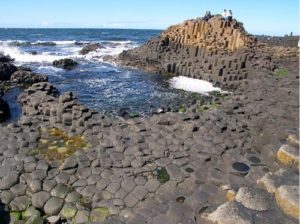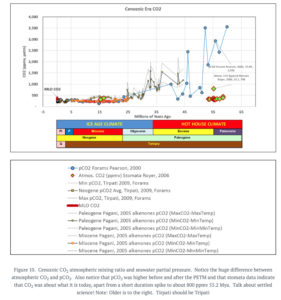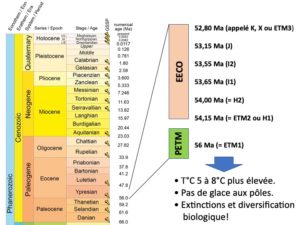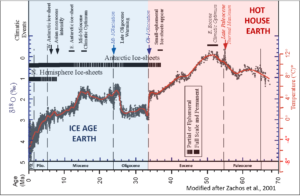by T. Smith et al., July 25, 2022 in PNAS
Abstract
True primates appeared suddenly on all three northern continents during the 100,000-yr-duration Paleocene–Eocene Thermal Maximum at the beginning of the Eocene, ≈55.5 mya. The simultaneous or nearly simultaneous appearance of euprimates on northern continents has been difficult to understand because the source area, immediate ancestors, and dispersal routes were all unknown. Now, omomyid haplorhine Teilhardinais known on all three continents in association with the carbon isotope excursion marking the Paleocene–Eocene Thermal Maximum. Relative position within the carbon isotope excursion indicates that Asian Teilhardina asiatica is oldest, European Teilhardina belgicais younger, and North American Teilhardina brandti and Teilhardina americana are, successively, youngest. Analysis of morphological characteristics of all four species supports an Asian origin and a westward Asia-to-Europe-to-North America dispersal for Teilhardina. High-resolution isotope stratigraphy indicates that this dispersal happened in an interval of ≈25,000 yr. Rapid geographic dispersal and morphological character evolution in Teilhardina reported here are consistent with rates observed in other contexts.
…
by Andy May, Aug 18, 2021 in WUWT
The PETM or Paleocene-Eocene Thermal Maximum was a warm period that began between 56.3 and 55.9 Ma (million years ago). The IPCC AR6 report (actually a draft, not a final edited report), released to the public on August 9, 2021, suggests that this warm period is similar to what is happening today and they expect to happen in the future (IPCC, 2021, pp. 2-82 & 5-14). During the PETM, it was very warm and average global surface temperatures probably peaked between 25.5°C and 26°C briefly, compared to a global surface temperature average of about 14.5°C today, as shown in Figure 1.
….
oday we have tens of thousands of daily temperature measurements around the world and can calculate a fairly accurate global average surface temperature. To construct a global average for the PETM we must rely on proxy temperatures, such as oxygen isotope ratios, Calcium/Magnesium ratios in fossil shells, and fossil membrane lipids that are sensitive to temperature like Tex86. Proxy temperature values are sparsely located and have a temporal resolution, 56 Ma, of thousands to hundreds of thousands of years. Thus, in terms of rate of temperature change, they are not comparable to today’s monthly global averages.
Before diving into the PETM, we will provide some geological perspective. According to Christopher Scotese, the highest global average temperature in the Phanerozoic (the age of complex shelled organisms, or the past 550 million years) was the Triassic hothouse event, following the end of the Karoo Ice Age, around 250-300 Ma. Global average surface temperatures peaked then at about 27.9°C.
…
by H. Lee, April 1, 2020 in ClimateChangeDispatch
A study has cemented the link between an intense global warming episode 56 million years ago and volcanism in the North Atlantic, with implications for modern climate change.
Roughly 60 million years ago, circulation changes deep within our planet generated a hot current of rock — the Iceland plume — causing it to rise from the heart of Earth’s mantle.
…
…

The Giant’s Causeway in Northern Ireland is a geologic feature consisting of thousands of interlocking basalt columns that formed from volcanic eruptions 60 million years ago.
The Wrong Kind Of Carbon
Although a great deal of North Atlantic volcanism happened close in time to the PETM, scientists were initially skeptical that it could have driven the warming.
Sedimentary layers that formed at the time had the wrong kind of carbon — they were rich in the isotope carbon-12, indicating an organic carbon source rather than a volcanic one.
The leading theory was that fluctuations in Earth’s orbit around the sun melted a type of frozen methane just beneath the seabed called methane clathrates.
Yet scientists found scant evidence that enough clathrates existed in the pre-PETM world, or that they could have melted fast enough to drive the warming.
A possible missing link between the North Atlantic Igneous Province and organic carbon was spotted in 2004 in seismic scans through the seabed off the coast of Norway.
Continuer la lecture de Magma Flood Linked To Sudden Ancient Global Warming Event →
by David Middleton, September 30, 2019 in WUWT
Key points
- The Eocene was, on average, 4–15 °C warmer than today.
- Atmospheric CO2 was very likely in the 450-600 ppm range.
- Modern climate models would require 4,500 ppm CO2 to simulate the Eocene temperature range;
- And/or a climate sensitivity of 4-8 °C per doubling;
- And/or “that other climate forcings were stronger than previously assumed”.
They totally missed the most obvious reason why just about every effort to gin up a paleo example of CO2-driven climate change falls apart: Atmospheric CO2 is not a primary driver of climate change over geologic time. This wouldn’t mean that it isn’t a greenhouse gas or that it has no effect on temperature. It would simply mean that it was a relatively minor climate driver, like volcanic eruptions.
At some point over the past 30 years or so, the assumption that CO2 drives modern climate change has become a paradigm. And I think we have seen a rare failure in the application of the geologic principle of Uniformitarianism.
Uniformitarianism is often incorrectly cited as the reason geologists were slow to accept plate tectonics, the impact theory of the K-Pg extinction and why the hypotheses for a Younger Dryas impact and abiotic oil are generally unaccepted. However, Uniformitarianism may be why a CO2-driven climate paradigm appears to have come into wide acceptance, at least in academia.
…

Figure 3a. Marine pCO2 (foram boron δ11B, alkenone δ13C), atmospheric CO2 from plant stomata (green and yellow diamonds with red outlines), Mauna Loa instrumental CO2 (thick red line) and Cenozoic temperature change from benthic foram δ18O (light gray line).
…
by A. Jacobs & A. Préat, May 20, 2019 in SSRN.Elsevier
The focus of this study is based on a detailed analysis of the hyperthermal events of the
Paleocene / Eocene limit of 56 Ma and the lower Eocene (for the 54-52 Ma interval, Figure 1).
This example will show that the Earth has experienced many times much higher temperatures
than today, with warmer, sometimes more acidic oceans and an atmosphere much richer in CO2
(or CH4) than the current one. Are these past events precursors of the current situation?
Keywords: global warming, climate change, Paleocene, Eocene, hyperthermal events
…
by David Middleton, May 18, 2019 in WUWT
Gingerich, 2019 is a recent paper reiterating the PETM Chicken Little of the Sea meme. In the comments section of a recent post, it was cited as evidence of imminent catastrophe and followed up by a comment featuring this image from Clean Tecnica:
…
I just had to track this back to the Clean Tecnica article… Their scientific prowess is almost always laughable… And I was not disappointed.
…

by A. Préat & A. Jacobs, 17 avril 2019 in ScienceClimatEnergie
Le but de cet article est de montrer combien la climatologie (actuelle et celle du passé) est complexe et que’ la science est loin d’être dite’. Pour ce qui est de la climatologie actuelle de très nombreux articles existent, dont une partie sur SCE. Pour la climatologie du passé les exemples géologiques ne manquent pas (également quelques articles généraux sur SCE, ici). Le propos de cet article est basé sur une analyse détaillée des événements hyperthermiques de la limite Paléocène/Eocène il y a 56 Ma et de l’Eocène inférieur (pour l’intervalle 54-52 Ma, Figure 1). Cet exemple montrera que la Terre a connu à de nombreuses reprises des températures bien plus élevées que celles d’aujourd’hui, avec des océans plus chauds, parfois plus acides et une atmosphère beaucoup plus riche en CO2 (ou en CH4) que l’actuelle. Cela n’a jamais empêché la vie de se développer, et ‘ironie du sort’ c’est au cours d’un de ces événements hyperthermiques du Tertiaire (ou PETM, voir plus loin), qui fut l’un des plus chauds qu’ait connu la Terre, que les mammifères ont poursuivi une radiation évolutive (= diversification des espèces) sans précédent entamée après l’extinction des dinosaures à la limite Crétacé/Tertiaire [1, 2].
…

by S. Beech, January 25, 2019 in ClimateChangeDispatch
A massive volcanic eruption in Scotland on the same scale as the infamous Krakatoa blast may have contributed to prehistoric global warming.
Scientists say that global temperatures spiked around 56 million years ago.
And a new study suggests that a major explosive eruption from the Red Hills on the Isle of Skye may have been a contributing factor to the massive climate disturbance.
Large explosive volcanic eruptions can have lasting effects on climate and have been held responsible for severe climate effects in Earth’s history.
One such event occurred around 56 million years ago when global temperatures increased by up to 8 degrees Celcius (46 degrees Fahrenheit.)
The event has been named the Paleocene-Eocene Thermal Maximum (PETM).
…
by David Middleton, January 23, 2019 in WUWT
…
Note how the PETM (55 Ma) is about as far from a CO2 analog to modern times as it possibly could be… unless the PETM stomata data are correct, in which case AGW is even more insignificant than previously thought.
Regarding temperatures, the PETM is also about as far from being an analog to modern times as it possibly could be.

Figure 2. High latitude SST (°C) From benthic foram δ18O. Funny how the PETM is often cited as a nightmarish version of a real-world RCP8.5… While the warmer EECO is a climatic optimum. (Zachos et al., 2001). Note: Older is to the right.
…
by Anthony Watts, September 4, 2018 in WUWT
From the University of Bristol and the “models before measurements” department comes this highly speculative claim that is entirely based entirely on climate models. There’s no actual measured data from any sort of paleo research. It’s science, but not as we know it.
A new study by scientists at the University of Bristol has shown that ancient global warming was associated with intense rainfall events that had a profound impact on the land and coastal seas.
The Palaeocene-Eocene Thermal Maximum (PETM), which occurred about 56 Million years ago, is of great interest to climate scientists because it represents a relatively rapid global warming event, with some similarities to the human-induced warming of today.
Although there have been many investigations of how much the Earth warmed at the PETM, there have been relatively few studies of how that changed the hydrological cycle.
by Anthony Watts, August 10, 2018 in WUWT
Syracuse University professor uses ancient marine sediment as benchmark for present, future climate models
SYRACUSE, N.Y. – Researchers at Syracuse University are looking to the geologic past to make future projections about climate change.
Christopher K. Junium, assistant professor of Earth sciences in the College of Arts and Sciences (A&S), is the lead author of a study that uses the nitrogen isotopic composition of sediments to understand changes in marine conditions during the Paleocene-Eocene Thermal Maximum (PETM)–a brief period of rapid global warming approximately 56 million years ago.
Junium’s team–which includes Benjamin T. Uveges G’17, a Ph.D. candidate in A&S, and Alexander J. Dickson, a lecturer in geochemistry at Royal Holloway at the University of London–has published an article on the subject in Nature Communications (Springer Nature, 2018).
…
La géologie, une science plus que passionnante … et diverse






